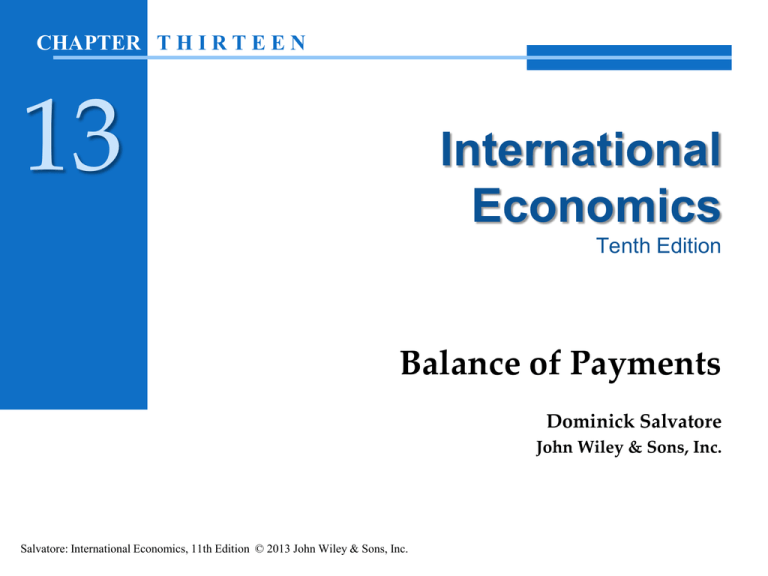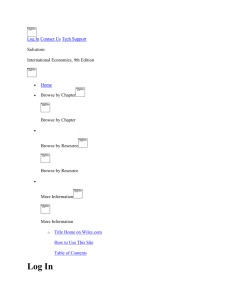
CHAPTER T H I R T E E N
13
International
Economics
Tenth Edition
Balance of Payments
Dominick Salvatore
John Wiley & Sons, Inc.
Salvatore: International Economics, 11th Edition © 2013 John Wiley & Sons, Inc.
Learning Goals:
Understand what the balance of payment is and
what it measures
Describe the change in the U.S. balance of
payments over the years
Understand the importance of the serious
deterioration of the trade balance and net
international investment position of the United
States in recent years.
Salvatore: International Economics, 11th Edition © 2013 John Wiley & Sons, Inc.
Introduction
The balance of payments provides a summary
statement of international transactions for a
nation for a specified period of time.
An international transaction is the exchange of a
good, service or asset between residents of one
nation and residents of another nation.
The main purpose of the balance of payments is
to help the government in formulation monetary,
fiscal and trade policies.
Salvatore: International Economics, 11th Edition © 2013 John Wiley & Sons, Inc.
Balance of Payments Accounting Principles
Credit transactions (+)
Transactions that involve receipt of payments
from foreign sources.
Major types:
Exports of goods and services
Unilateral transfers (gifts) from foreigners
Financial inflows
Increase in foreign assets in a nation
Reduction in a nation’s assets abroad
Salvatore: International Economics, 11th Edition © 2013 John Wiley & Sons, Inc.
Balance of Payments Accounting Principles
Debit transactions (-)
Transactions that involve payment to foreign
sources.
Major types:
Imports of goods and services
Unilateral transfers (gifts) to foreigners
Financial outflows
Increase in a nation’s assets abroad
Reduction in foreign assets in a nation
Salvatore: International Economics, 11th Edition © 2013 John Wiley & Sons, Inc.
Balance of Payments Accounting Principles
In balance of payment accounting, each
international transaction is recorded twice – once
as a credit, once as a debit.
Examples:
$500 in exports to be paid in 3 months time
Credit (+)
Goods export
Debit (-)
$500
Financial outflow
Salvatore: International Economics, 11th Edition © 2013 John Wiley & Sons, Inc.
$500
Balance of Payments Accounting Principles
In balance of payment accounting, each
international transaction is recorded twice – once
as a credit, once as a debit.
Examples:
$200 spent by a U.S. tourist in London on services
Credit (+)
Travel services (purchased
from foreigners)
Financial inflow
Salvatore: International Economics, 11th Edition © 2013 John Wiley & Sons, Inc.
Debit (-)
$200
$200
Balance of Payments Accounting Principles
In balance of payment accounting, each
international transaction is recorded twice – once
as a credit, once as a debit.
Examples:
$100 in US government foreign aid given to the
government of a developing nation
Credit (+)
Unilateral transfers made
Financial inflow
Salvatore: International Economics, 11th Edition © 2013 John Wiley & Sons, Inc.
Debit (-)
$100
$100
Balance of Payments Accounting Principles
In balance of payment accounting, each
international transaction is recorded twice – once
as a credit, once as a debit.
Examples:
$400 in foreign stock purchased by U.S. resident
Credit (+)
Financial outflow (purchase of foreign
stock by U.S resident)
Financial inflow (increase in foreign
bank balances in U.S.)
Salvatore: International Economics, 11th Edition © 2013 John Wiley & Sons, Inc.
Debit (-)
$400
$400
Balance of Payments Accounting Principles
In balance of payment accounting, each
international transaction is recorded twice – once
as a credit, once as a debit.
Examples:
$300 of U.S. Treasury bills purchased by foreign
investor from his U.S. bank account
Credit (+)
Financial inflow (purchase of U.S.
Treasury bills by foreigner)
Financial outflow (reduction in
foreign bank balances in U.S.)
Salvatore: International Economics, 11th Edition © 2013 John Wiley & Sons, Inc.
Debit (-)
$300
$300
The International Transactions of the United
States
Salvatore: International Economics, 11th Edition © 2013 John Wiley & Sons, Inc.
The International Transactions of the United
States
Salvatore: International Economics, 11th Edition © 2013 John Wiley & Sons, Inc.
Accounting Balances and the Balance of
Payments
Current Account
All sales and purchases of currently produced
goods and services, investment incomes and
unilateral transfers, providing link between
international transactions and national
income.
Current account surplus stimulates domestic
production and income
Current account deficit dampens domestic
production and income
Salvatore: International Economics, 11th Edition © 2013 John Wiley & Sons, Inc.
Accounting Balances and the Balance of
Payments
Capital Account
Includes debt forgiveness and goods and
financial assets that migrants take with them
as they leave or enter the country.
The U.S. deficit in the current and capital
accounts in 2007 are financed or covered by an
equal net inflow of capital abroad.
Salvatore: International Economics, 11th Edition © 2013 John Wiley & Sons, Inc.
Accounting Balances and the Balance of
Payments
Financial Account
Shows the change in U.S.-owned assets abroad
and foreign-owned assets in the United States.
The U.S. covers its current and capital account
deficits with an equal net financial account
surplus.
Salvatore: International Economics, 11th Edition © 2013 John Wiley & Sons, Inc.
Accounting Balances and the Balance of
Payments
If net private capital inflows do not cover the
current and capital accounts deficit, the nation has
a deficit in its balance of payments equal to the
difference, which needs to be covered by a net
credit balance on official (i.e., monetary authorities’)
reserve transactions.
Official settlements balance - The balance on official
reserve transactions, also called the balance of
payments.
Official reserve account – The account in which
official reserve transactions are entered.
Salvatore: International Economics, 11th Edition © 2013 John Wiley & Sons, Inc.
Accounting Balances and the Balance of
Payments
Current account balance
+ capital account balance
+ financial account balance (less official reserve
transactions, but including net balance of financial derivatives)
+ statistical discrepancy
Balance of Payments
Salvatore: International Economics, 11th Edition © 2013 John Wiley & Sons, Inc.
Accounting Balances and the Balance of
Payments
Deficit in the balance of payments (negative sum of
- covered by an equal amount
official reserves transaction (reduction in
international reserves of the nation or increase in
foreign holdings of official assets of the nation).
account balances)
Surplus in the balance of payments (positive sum of
- settled by an increase in the
nation’s international reserves and/or reduction in
foreign official holdings of nation’s assets.
account balances)
Salvatore: International Economics, 11th Edition © 2013 John Wiley & Sons, Inc.
The Postwar Balance of Payments of the
United States
Points to keep in mind when examining
balance of payments:
1.
Too much attention is usually placed on
balance of goods and short term data.
Dangerous to extrapolate for year based on
quarterly data.
Salvatore: International Economics, 11th Edition © 2013 John Wiley & Sons, Inc.
The Postwar Balance of Payments of the
United States
Points to keep in mind when examining
balance of payments:
2.
International transactions are closely
interrelated rather than independent.
For example, cutting U.S. foreign aid programs
also reduces ability of recipients to import U.S.
goods, so improvement in U.S. balance of
payments may be much less than reduction in
aid.
Salvatore: International Economics, 11th Edition © 2013 John Wiley & Sons, Inc.
The Postwar Balance of Payments of the
United States
Points to keep in mind when examining
balance of payments:
3.
An attempt to reduce the U.S. trade deficit
with respect to a nation such as Japan is
likely to reduce the U.S. surplus with respect
to Brazil because Brazil pays for U.S. goods
partly through natural resource exports to
Japan.
Salvatore: International Economics, 11th Edition © 2013 John Wiley & Sons, Inc.
The Postwar Balance of Payments of the
United States
Salvatore: International Economics, 11th Edition © 2013 John Wiley & Sons, Inc.
The Postwar Balance of Payments of the
United States
Salvatore: International Economics, 11th Edition © 2013 John Wiley & Sons, Inc.
The International Investment Position of the
United States
Salvatore: International Economics, 11th Edition © 2013 John Wiley & Sons, Inc.
The International Investment Position of the
United States
A nation’s BOP measures international flow
of goods, services and capital during a oneyear period (flow concept).
A nation’s international investment position
measures total amount and distribution of
assets abroad and foreign assets in the nation
at the end of the year (stock concept).
Salvatore: International Economics, 11th Edition © 2013 John Wiley & Sons, Inc.
The International Investment Position of the
United States
Also known as balance of international
indebtedness.
Useful in projecting the future flow of income
from U.S. foreign investments and payments
on foreign investments in the U.S.
Salvatore: International Economics, 11th Edition © 2013 John Wiley & Sons, Inc.
FIGURE 13-3 The U.S. Current Account Balance and the Net Investment Position,
1980-2011
Salvatore: International Economics, 11th Edition © 2013 John Wiley & Sons, Inc.
Case Study 13-1 The Major Goods Exports
and Imports of the United States
Salvatore: International Economics, 11th Edition © 2013 John Wiley & Sons, Inc.
Case Study 13-2 The Major Trade Partners of
the United States
Salvatore: International Economics, 11th Edition © 2013 John Wiley & Sons, Inc.
Case Study 13-3 The U.S. Trade Deficit with
Japan
FIGURE 13-1 The U.S. Trade Balance with Japan in Goods and in
Goods and Services, 1980-2011.
Salvatore: International Economics, 11th Edition © 2013 John Wiley & Sons, Inc.
Case Study 13-4 The Exploding U.S. Trade
Deficit with China
FIGURE 13-2 U.S. Exports, Imports, and Net Trade Balance in
Goods with China, 1985-2011 (billions of dollars).
Salvatore: International Economics, 11th Edition © 2013 John Wiley & Sons, Inc.
Appendix: The IMF Method of Reporting
International Transactions
Salvatore: International Economics, 11th Edition © 2013 John Wiley & Sons, Inc.
Appendix: The IMF Method of Reporting
International Transactions
Salvatore: International Economics, 11th Edition © 2013 John Wiley & Sons, Inc.
Appendix: The IMF Method of Reporting
International Transactions
Salvatore: International Economics, 11th Edition © 2013 John Wiley & Sons, Inc.
Appendix: The IMF Method of Reporting
International Transactions
Salvatore: International Economics, 11th Edition © 2013 John Wiley & Sons, Inc.
Copyright 2013 John Wiley & Sons, Inc.
All rights reserved. Reproduction or translation of this work beyond
that permitted in section 117 of the 1976 United States Copyright Act
without express permission of the copyright owner is unlawful.
Request for further information should be addressed to the
Permissions Department, John Wiley & Sons, Inc. The purchaser may
make back-up copies for his/her own use only and not for distribution
or resale. The Publisher assumes no responsibility for errors, omissions,
or damages caused by the use of these programs or from the use of the
information herein.
Salvatore: International Economics, 11th Edition © 2013 John Wiley & Sons, Inc.






